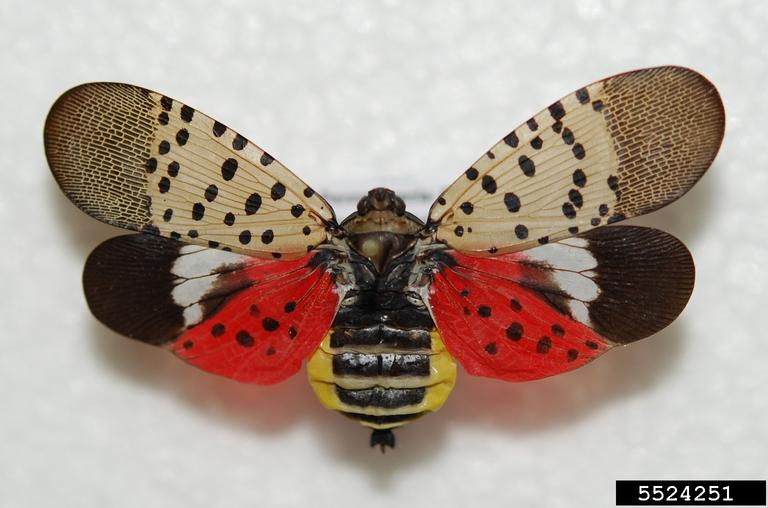By Anne Pearce, Invasive Plants Association of Wisconsin
Spotted lanternfly is on its way to Wisconsin

Tree-of-heaven showing leaves and fruits. Photo: Chuck Bargeron, University of Georgia, Bugwood.org
Spotted lanternfly (Lycorma delicatula) is an invasive insect that threatens a variety of plant species, mostly woody plants. It has not yet been found in Wisconsin, but it is steadily moving toward us from the eastern United States. Both juvenile (nymphs) and adult spotted lanternfly feed by sucking sap from the stem, branches, twigs and leaves of host plants. This weakens the plant and can contribute to the plant’s death. Because spotted lanternfly impacts a wide variety of agricultural crops (like grapes and hops), nursery crops (like roses), and hardwood trees (like maple, walnut, willow, and poplar), it is a high priority pest in Wisconsin.
The more eyes we have looking for spotted lanternfly, the more likely we will detect it when it arrives in Wisconsin and be better able to mitigate its impacts. Spotted lanternfly is a distinct-looking insect in all its life stages. You can learn more about spotted lanternfly at the Wisconsin Department of Agriculture, Trade and Consumer Protection’s (DATCP) website. If you think you’ve found spotted lanternfly, report it right away to DATCP’s reporting form.

Adult spotted laternfly. Photo: Lawrence Barringer, Pennsylvania Department of Agriculture, Bugwood.org

Later-stage nymph. Lawrence Barringer, Pennsylvania Department of Agriculture, Bugwood.org
Tree-of-heaven may help with early detection
So where does tree-of-heaven fit into the picture? Despite having a wide range of host plants, spotted lanternfly prefer tree-of-heaven (Ailanthus altissima), which is invasive in Wisconsin. That creates an opportunity to focus monitoring efforts for spotted lanternfly insects and egg masses on areas where tree-of-heaven is growing. Here’s where we need your help! Wisconsin First Detector Network (WIFDN) works with volunteers and partner organizations across Wisconsin to track invasive plant species. WIFDN’s goal is to create a complete and accurate map of tree-of-heaven locations in Wisconsin. With that map in hand, pest survey specialists and volunteers can coordinate and prioritize spotted lanternfly monitoring efforts. We know tree-of-heaven is widespread in urban areas (especially Milwaukee and Madison), but specific locations are not well-mapped. We also don’t have complete information on where tree-of-heaven grows outside of these urban centers or how far north and west it grows in Wisconsin. If you spot tree-of-heaven, please report it! You can either email WIFDN at WIFDN@extension.wisc.edu OR submit a report with the EDDMapS App (more on EDDMapS below).
No matter how you report, your report should include:
- The date you saw the tree-of-heaven
- GPS location of the tree-of-heaven
- Photo(s) for verifying the identification
You can include any additional information!
Identifying tree-of-heaven and look-alikes
Tree-of-heaven is a rapidly-growing tree with alternate branching and large (1-4+ ft) compound leaves. Leaflets have smooth margins except for a few glandular teeth at the base of each leaflet. Leaves often have a rancid peanut smell. Upright clusters of tiny whitish flowers develop into drooping clusters of samaras. In Wisconsin, the most common look-alike species are sumacs (Rhus spp.) and walnut/butternut (Juglans spp.), which also have alternate branching and compound leaves. However, the Rhus spp. and Juglans spp. all have toothed leaflets and fruits that are distinct (upright clusters of reddish fruits in the sumacs and nuts for the walnut/butternut). Check out WIFDN’s tree-of-heaven identification video and look-alike guide for more information! Both resources are on WIFDN’s spotted lanternfly webpage.
Use the EDDMapS App to report any invasive species
If you encounter invasive species (plants, insects, etc.) often, you can document locations for your own work or to contribute to citizen science using the EDDMapS App. EDDMapS is the largest invasive species database in North America, and its reporting apps make it easy for anyone to report locations of invasive species. Reports are verified by local experts before being added to the database, and verified reports are available to all EDDMapS users. EDDMapS users include natural resource agencies, researchers, volunteers, landowners and more! The WIFDN website has all the information you need to get started with the EDDMapS App. Go to fyi.extension.wisc.edu/wifdn and click on “I want to Report Invasive Species.”
This article first appeared in the Wisconsin Arborist Association’s Spring 2023 newsletter.
